Geology Test 3 Test Questions – Flashcards
Unlock all answers in this set
Unlock answersquestion
amniote egg
answer
The type of egg produced by reptiles, birds, and prototherian (egg-laying) mammals
question
angiosperms
answer
a plant that has flowers and produces seeds enclosed within a carpel. The angiosperms are a large group and include herbaceous plants, shrubs, grasses, and most trees.
question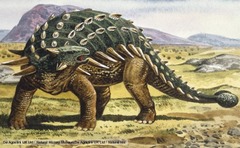
Ankylosaurians

answer
s a genus of armored dinosaur. Fossils of Ankylosaurus have been found in geological formations dating to the very end of the Cretaceous Period,
question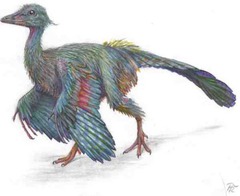
archeopteryx

answer
a genus of bird-like dinosaurs that is transitional between non-avian feathered dinosaurs and modern birds
question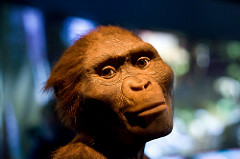
Australopithicus

answer
Australopithecus is an extinct genus of hominins. evolved in eastern Africa around 4 million years ago (southern ape)
question
Basal Archosaurs
answer
a group of diapsid amniotes whose living representatives consist of birds and crocodilians.
question
Bering Land Bridge
answer
Beringia is defined today as the land and maritime area bounded on the west by the Lena River in Russia; on the east by the Mackenzie River in Canada
question
Birds
answer
Birds bro, birds....
question
Breakup of Pangea
answer
broke apart about 200 million years ago. At this time most of the dry land on Earth was joined into one huge landmass that covered nearly a third of the planet's surface.
question
Breakup of Rodinia
answer
broke up again before 750 million years ago.
question
carbonization
answer
the term for the conversion of an organic substance into carbon or a carbon-containing residue through pyrolysis or destructive distillation.
question
Cenozoic
answer
The Cenozoic spans only about 65 million years, from the end of the Cretaceous Period and the extinction of non-avian dinosaurs to the present.
question
Ceratopsians
answer
a group of herbivorous, beaked dinosaurs that thrived in what are now North America, Europe, and Asia, during the Cretaceous Period, although ancestral forms lived earlier, in the Jurassic.
question
coevolution
answer
the influence of closely associated species on each other in their evolution.
question
convergent evolution
answer
the process whereby organisms not closely related (not monophyletic), independently evolve similar traits as a result of having to adapt to similar environments or ecological niches.
question
Cretaceous
answer
the last and longest segment of the Mesozoic Era. It lasted approximately 79 million years, from the minor extinction event that closed the Jurassic Period about
question
Destruction of Alderaan
answer
Starwars lol
question
differentiated teeth
answer
There are four kinds of teeth in mammals: (1) incisors (for nipping), (2) canines for grasping prey, and cheekteeth of two kinds--(3) premolars ("bicuspids" in humans) and (4) molars--for shearing or grinding the food
question
Dinosaurs
answer
Dinos bro.
question
eons
answer
an indefinite and very long period of time, often a period exaggerated for humorous or rhetorical effect.
question
epicontinental seas
answer
a shallow sea that covers central areas of continents during periods of high sea level that result in marine transgressions.
question
epochs
answer
a division of time that is a subdivision of a period and is itself subdivided into ages, corresponding to a series in chronostratigraphy.
question
eras
answer
a subdivision of geologic time that divides an eon into smaller units of time.
question
Formation of Pangea
answer
formed about 270 million years ago
question
fossils
answer
Bones of dinosaurs preserved
question
gulfstream
answer
A river of sea water, called the Atlantic North Equatorial Current, flows westward off the coast of Central Africa. ... This overall process, known as western intensification, causes currents on the western boundary of an ocean basin, such as the Gulf Stream
question
gymnosperm
answer
a group of seed-producing plants that includes conifers, cycads, Ginkgo, and gnetophytes. The term "gymnosperm" comes from the Greek composite word γυμνόσπερμος, meaning "naked seeds"
question
hadrosaurs
answer
duck-billed dinosaurs, are members of the ornithischian family Hadrosauridae. This group is also known as the duck-billed dinosaurs, for the flat, duck-bill appearance of their mouths.
question
Holocene
answer
the geological epoch that began after the Pleistocene at approximately 11,700 years before present.
question
Hominidea
answer
The Hominidae, whose members are known as great apes or hominids, are a taxonomic family of primates that includes seven extant species
question
Homo Erectus
answer
The upright man
question
Homo Habilis
answer
Homo habilis was a species of the tribe Hominini, during the Gelasian and early Calabrian stages of the Pleistocene period, which lived between roughly 2.1 and 1.5 million years ago
question
Homo Sapien
answer
Human
question
Horses
answer
A horse
question
ichthyosaurs
answer
Ichthyosaurs are large marine reptiles. Ichthyosaurs belong to the order known as Ichthyosauria or Ichthyopterygia
question
index fossil
answer
a fossil that is useful for dating and correlating the strata in which it is found
question
India
answer
A place called india
question
Jurassic
answer
The Jurassic Period was the second segment of the Mesozoic Era. It occurred from 199.6 to 145.5 million years ago, following the Triassic Period and preceding the Cretaceous Period.
question
Lizards
answer
A lizard
question
Mammals
answer
Mammals are any vertebrates within the class Mammalia, a clade of endothermic amniotes distinguished from reptiles by the possession of a neocortex, hair, three middle ear bones and mammary glands
question
Mesozoic
answer
The Mesozoic Era lasted about 180 million years, and is divided into three periods, the Triassic, the Jurassic, and the Cretaceous.
question
molds/casts
answer
If the space is subsequently filled with sediment, an external cast can be made. Molds and casts are three dimensional and preserve the surface contours of the organism.
question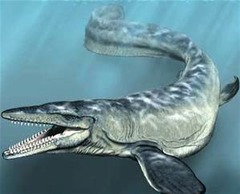
Mosasaurs

answer
Mosasaurs are an extinct group of large marine reptiles. Their first fossil remains were discovered in a limestone quarry at Maastricht on the Meuse in 1764.
question
natural selection
answer
the differential survival and reproduction of individuals due to differences in phenotype. It is a key mechanism of evolution, the change in heritable traits of a population over time.
question
Neogene
answer
a geologic period and system that spans 20.45 million years from the end of the Paleogene Period 23.03 million years ago (Mya) to the beginning of the present Quaternary Period 2.58 Mya.
question
non-vascular plants
answer
plants without a vascular system consisting of xylem and phloem. Although non-vascular plants lack these particular tissues, many possess simpler tissues that are specialized for internal transport of water
question
Orbit
answer
Things in orbit
question
Ornithischians
answer
an extinct clade of mainly herbivorous dinosaurs characterized by a pelvic structure similar to that of birds
question
Paleogene
answer
relating to or denoting the earlier division of the Tertiary period, comprising the Paleocene, Eocene, and Oligocene epochs.
question
Paleozoic
answer
of the Phanerozoic eras, and is subdivided into six geologic periods (from oldest to youngest): the Cambrian, Ordovician, Silurian, Devonian, Carboniferous, and Permian. The Paleozoic comes after the Neoproterozoic era of the Proterozoic and is followed by the Mesozoic
question
Panamanian Land Bridge
answer
The Isthmus of Panama, also historically known as the Isthmus of Darien, is the narrow strip of land that lies between the Caribbean Sea and the Pacific Ocean, linking North and South America.
question
Pangea
answer
a supercontinent that existed during the late Paleozoic and early Mesozoic eras.
question
permineralization
answer
a process of fossilization in which mineral deposits form internal casts of organisms. Carried by water, these minerals fill the spaces within organic tissue.
question
Phanerozoic Eon
answer
a period of geological history that spans 542 million years and is typically subdivided into three eras. These eras are: Paleozoic Era: 542 to 251 million years ago. Mesozoic Era: 251 to 65 million years ago. Cenozoic Era: 65 million years ago to present.
question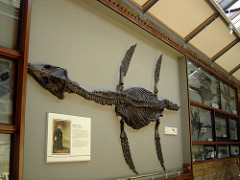
Pleisiosaurs

answer
are an order or clade of Mesozoic marine reptiles, belonging to the Sauropterygia. Plesiosaurs first appeared in the latest Triassic Period, possibly in the Rhaetian stage, about 203 million years ago.
question
Pleistocene
answer
relating to or denoting the first epoch of the Quaternary period, between the Pliocene and Holocene epochs.
question
Pleistocene Extinction Event
answer
Approximately 11,000 years ago a variety of animals went extinct across North America. These were mostly mammals larger than approximately 44 kg
question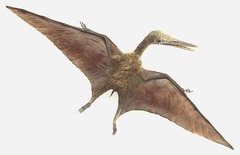
Pterosaurs

answer
flying reptiles of the extinct clade or order Pterosauria. They existed from the late Triassic to the end of the Cretaceous. Pterosaurs are the earliest vertebrates known to have evolved powered flight.
question
Quaternary
answer
the current and most recent of the three periods of the Cenozoic Era in the geologic time scale of the International Commission on Stratigraphy.
question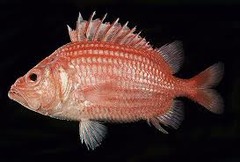
Ray finned fish

answer
Actinopterygii, or the ray-finned fishes, constitute a class or subclass of the bony fishes. The ray-finned fishes are so called because they possess lepidotrichia or "fin rays", their fins being webs
question
replacement
answer
the action or process of replacing someone or something
question
Saurischians
answer
Saurischia is one of the two basic divisions of dinosaurs. In 1888, Harry Seeley classified dinosaurs into two orders, based on their hip structure
question
Sauropods
answer
an infraorder of saurischian dinosaurs. They had very long necks, long tails, small heads, and four thick, pillar-like legs.
question
sea turtles
answer
turtles of the sea, early cretacious. one of the few reptiles that survived
question
Snakes
answer
land worms that eat stuff
question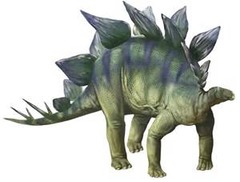
Stegosaurians

answer
a genus of armored dinosaur. Fossils of this genus date to the Late Jurassic period, where they are found in Kimmeridgian to early Tithonian aged strata, between 155 and 150 million years
question
subduction zone
answer
the biggest crash scene on Earth. These boundaries mark the collision between two of the planet's tectonic plates. The plates are pieces of crust that slowly move across the planet's surface over millions of years.
question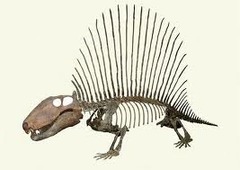
Synapsids

answer
synonymous with theropsids, are a group of animals that includes mammals and every animal more closely related to mammals than to other living amniotes
question
Tauntaun
answer
Star wars lol
question
Therapsids
answer
a group of synapsids that includes mammals and their ancestors. Many of the traits today seen as unique to mammals had their origin within early therapsids
question
Theropods
answer
a group of saurischian dinosaurs. Theropods were ancestrally carnivorous, although a number of theropod groups evolved herbivory, omnivory, piscivory, and insectivory.
question
Triassic
answer
a geologic period and system which spans 50.9 million years from the end of the Permian Period 252.17 million years ago (Mya), to the beginning of the Jurassic Period 201.3 Mya. The Triassic is the first period of
question
tribles
answer
a social division in a traditional society consisting of families or communities linked by social, economic, religious, or blood ties, with a common culture and dialect, typically having a recognized leader.
question
Tuatara
answer
Tuatara are reptiles endemic to New Zealand. Although resembling most lizards, they are part of a distinct lineage, the order Rhynchocephalia. Their name derives from the Māori language, and means "peaks on the back"
question
turtles
answer
turtles on land
question
vascular system
answer
assemblage of conducting tissues and associated supportive fibres. Xylem tissue transports water and dissolved minerals to the leaves, and phloem tissue conducts food from the leaves to all parts of the plant.
question
warm shallow seas
answer
warm....shallow...seas
question
four stages of breakup of Pangea
answer
1:Rifting and volcanism along normal faults in the Triassic, resulting in the separation of North America (Laurasia) from Gondwanaland. Normal faulting in eastern North America, accompanied by the intrusion of dikes along fractures or cracks, along with lava flows and vent eruptions. Atlantic Ocean opened and widened through the extrusion of oceanic basalts. Note: The continents did not split along the places that marked their previous edges. The old suture (or "seam") between North America and Africa lies in southern Georgia. When Africa pulled away, it left a sliver of the African continent attached to the southeastern U.S. 2:Rifting and separation of Africa, India, and Antarctica. Large volumes of basalt were extruded. 3:The Atlantic rift extended northward, Eurasia moved clockwise (to the south), partially closing the Tethys Sea. South America began to split from Africa by the Late Jurassic, and completely separated by the Late Cretaceous. Australia remained connected with Antarctica. India was moving northward toward Asia. Greenland began to separate from Europe (Baltica), but remained attached to North America (Laurentia). 4:After the Mesozoic, the breakup of Pangea continued. North America (Laurentia) separated from Eurasia (Baltica) along the North Atlantic rift. Antarctica and Australia separated about 45 m.y. ago.
question
when did epicontinental seas cover North America?
answer
The late Cretaceous
question
Which invertebrate groups first appeared in the mesozoic?
answer
The Jurassic was the height of the dinosaur era, with giants such as Brachiosaurus, Stegosaurus, etc, and mammals tiny and shrew-like. Distinctive plants like ferns, Cycads, Bennettitales, and Cheirolepidiaceae conifers characterized the landscape. During the Cretaceous period, the first flowering plants appeared, birds and fish diversified, and new types of dinosaurs appeared
question
Which group of fish first appeared in the cretaceous?
answer
I CANT FIND SHIT ON FISH
question
6,000
answer
Humans started civilization in Mesopotamia
question
11,000
answer
end of the last glacial period
question
230 million
answer
Triassic extinction event
question
540 million
answer
Cambrian explosion (lots of new animals)
question
6 million
answer
no land bridge between north & south america india colliding with asia.



